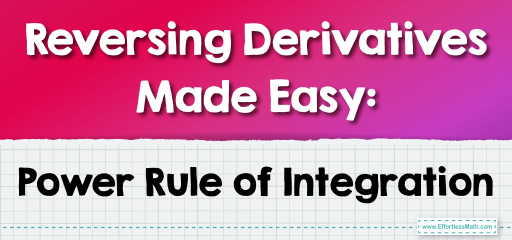Reversing Derivatives Made Easy: Power Rule of Integration

Definition of the Power Rule for Integration
The power rule states that for any real number \( n \) different from \(-1\), the integral of \( x^n \) with respect to \( x \) is:
\( \int x^n dx = \frac{x^{n+1}}{n+1} + C \)
where \( C \) is the constant of integration.
Why the Exclusion of \( n = -1 \)
The case where \( n = -1 \) is excluded because it leads to the function \( x^{-1} \), which is \( \frac{1}{x} \), and its integral is the natural logarithm function, not a power function. The integral of \( \frac{1}{x} \) is \( \ln|x| + C \).
Applying the Power Rule
General Application: To integrate a function like \( x^3 \), you would apply the power rule as follows:
\( \int x^3 dx = \frac{x^{3+1}}{3+1} + C = \frac{x^4}{4} + C \)
Negative Powers: It also applies to negative powers (except for \(-1\)). For instance:
\( \int x^{-2} dx = \frac{x^{-2+1}}{-2+1} + C = -\frac{1}{x} + C \)
Importance in Calculus
The power rule is a go-to technique for integrating polynomials and any function that can be expressed as a power of \( x \).
It simplifies the process of finding antiderivatives, which is crucial in solving problems involving areas under curves and in various physical applications.
Limitations
The power rule is not applicable to functions that cannot be expressed as \( x^n \). In such cases, other integration methods like substitution or integration by parts are required.
For \( n = -1 \), a different approach (integration of \( \frac{1}{x} \)) must be used.
Related to This Article
More math articles
- 6th Grade MCAS Math Practice Test Questions
- Order of Decimals, Mixed Numbers and Fractions
- How to Divide Exponents? (+FREE Worksheet!)
- 5th Grade Scantron Math Worksheets: FREE & Printable
- Everything Yоu Need to Pass the GED Mаth Test
- How to Use Area Models to Divide Two-Digit Numbers By One-digit Numbers
- What Topics Are Covered in Algebra 1?
- Top 10 5th Grade MCAS Math Practice Questions
- The Ultimate TASC Math Formula Cheat Sheet
- Top 10 7th Grade FSA Math Practice Questions














What people say about "Reversing Derivatives Made Easy: Power Rule of Integration - Effortless Math: We Help Students Learn to LOVE Mathematics"?
No one replied yet.